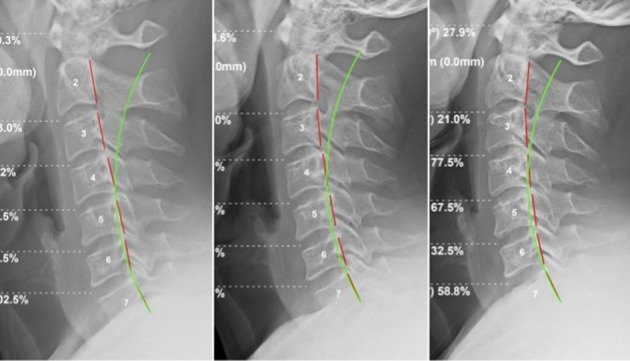Feeling Dizzy?
Alleviation of posttraumatic dizziness by restoration of the cervical lordosis: a CBP ® case study with a one-year follow-up
Miles O Fortner 1, Paul A Oakley 2, Deed E Harrison 3
PMID: 29765191PMCID: PMC5940483 DOI: 10.1589/jpts.30.730
May 2018
Abstract
[Purpose] To present the successful treatment of posttraumatic dizziness and neck pains that were initiated in a patient following a whiplash event.
[Subject and Methods] A 46 year old male suffered a whiplash event that initiated neck pain and dizziness symptoms. The patient had many positive orthopedic findings and demonstrated a forward head posture and cervical hypolordosis. The patient was treated by Chiropractic BioPhysics® technique including cervical extension traction, extension exercises and spinal manipulative therapy initially three times a week for 16-weeks, and once a month thereafter.
Fig. 1 Lateral cervical radiographs. Left: Initial (Apr. 27, 2016); Middle: 16-week follow-up (Aug. 5, 2016); Right: One year follow-up (May 4, 2017). From left to right demonstrates reduction of forward head translation (31.2 mm; 22.1 mm; 15.9 mm), increase in cervical lordosis (C2–C7 ARA: −17.4°; −23.2°; −30.4°), and increase in atlas plane line (C1 to horizontal: −2.8°; −12.0°; −20.9°). Note: red line indicates patient (posterior vertebral bodies); green line indicates ideal 42° C2–C7 lordosis from Harrison et al.14) (CBP Seminars).
[Results] The patient had a resolution of daily dizziness and neck pain with a concomitant reduction of forward head translation and increase in cervical lordosis. The postural measures were further improved after one year of mostly home-care.
[Conclusion] The cervical spine alignment may be an important biomarker for those with dizziness. The correction of cervical lordosis may be an essential requirement for superior clinical outcomes for those with posttraumatic dizziness.
Fig. 2 Cervical extension exercises. Patient stands on PowerPlate and extends head and neck backwards against resistance of Prolordotic elastic band tension.
Fig. 3 Cervical extension traction. Patient is seated with back against backrest, a padded fulcrum is placed at mid-neck and hooked through a pulley at approximately horizontal angle and weights are added to force the neck into an involuntary extended position. The head is held in place by the posterior and superior placed head harness that is locked to the metal frame.
Need to contact us for an assessment to correct this type of pain or dysfunction? Call now or visit our contact page.



